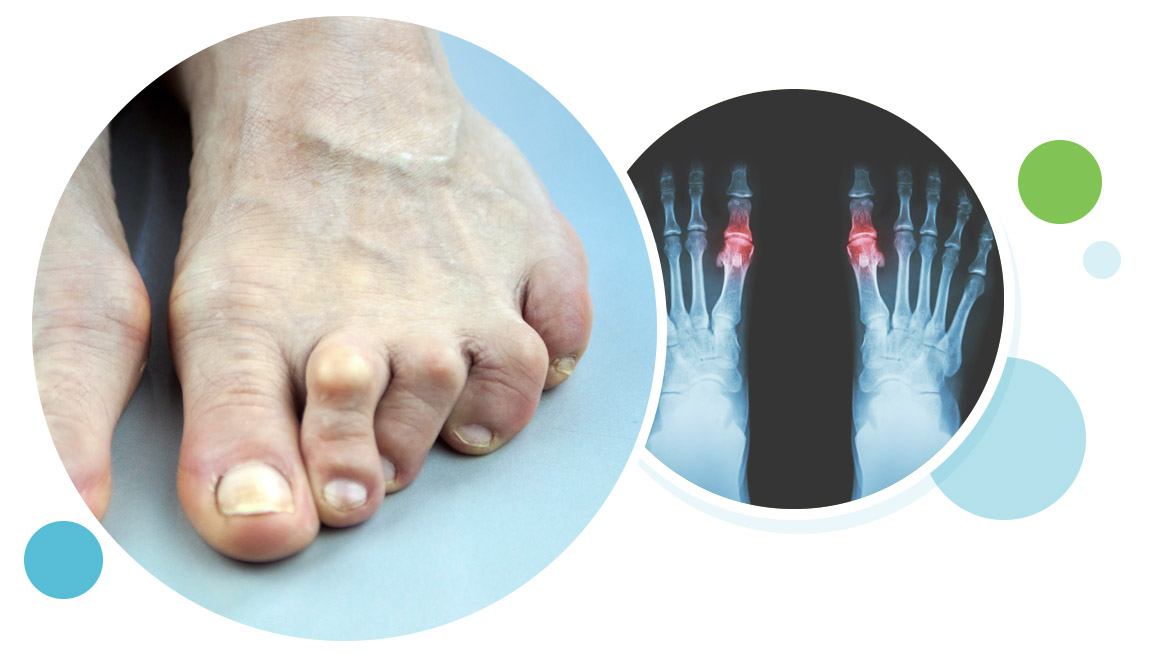Arthritis
Arthritis is the inflammation of one or more joints and is common in the small joints of the ankle and foot. The condition can make it difficult for the patient to walk or participate in other everyday activities. The ankle joint is comprised of three bones, which allow up and down movement while the foot has 28 bones and 30 joints allowing movement in various directions and ranges. Arthritis affects the cartilage of these joints, causing them to become less pliable, inflamed or causing degeneration. The three major kinds of arthritis that can affect the ankle and foot include post-traumatic arthritis, rheumatoid arthritis, a disease affecting the joint cartilage, and osteoarthritis which is caused by a breakdown of a joints cartilage. While there is no cure for arthritis, there are multiple treatment options to help slow the progress and to help relieve its symptoms.
Foot and Ankle Arthritis Symptoms
Patients with osteoarthritis or rheumatoid arthritis (RA) may experience swelling, stiffness and pain in the affected joint. Arthritis in the foot and ankle most commonly occurs in the outside of the ankle, the ball of the foot or near the front of the foot, affecting the big toe joint or lesser toe joints (metatarsophalangeal). Rheumatoid arthritis (RA) typically exhibits morning stiffness usually greater than 30 minutes, usually affecting multiple joints on both sides of the body. Osteoarthritis (OA) typically exhibits morning stiffness less than 30 minutes, usually affecting one or a few joints on one side of the body.
Diagnosing Arthritis
A podiatrist will conduct a physical examination to check for swelling and levels of joint flexibility. They may conduct a gait analysis, where the doctor will observe how you walk. If arthritis is suspected to be the cause of the swelling and pain, X-rays may be a necessary next step. Other imaging tests, such as an MRI, or a CT might be needed to determine the condition of the soft tissues and bones. These images can show if there is narrowing of the joint spaces between bones, the formation of bone spurs and can detect any changes in the bones. If rheumatoid arthritis is suspected blood tests may be used to accurately diagnose the disease.
Treating Arthritis
Non-Surgical
While arthritis cannot be cured, there are several treatment options to prolong joint health and reduce the pain that it causes. Depending on the extent of the arthritis, conservative options can be utilized. These treatment options might include:
- Lifestyle modifications – reducing activities that aggravate the condition, switching from high-impact activities to lower impact activities, losing weight to reduce stress on the joints.
- Physical therapy – there are specific exercises that can improve the range of flexibility and motion, while strengthening the muscles of the ankle and foot.
- Assistive devices – wearing a brace or using a cane can help with safety and mobility; sometimes shoe inserts or custom-made shoes with rocker bottoms and stiff soles can decrease pain and minimize pressure on the foot.
- Medications – Non-steroidal anti-inflammatory drugs (NSAIDs) can help with the pain and swelling; sometimes cortisone is injected in the arthritic joint, but the relief is temporary.
Surgical Treatment
If the pain is not relieved by non-surgical options, surgical treatment might be recommended. There are different surgical options:
- Arthroscopic debridement – loose cartilage, bone spurs, and inflamed synovial tissue are removed.
- Fusion (arthrodesis) – The bones of the joint are completely fused, so one bone is made from two or more bones. This procedure is to eliminate motion in the arthritic joint and reduce pain.
- Arthroplasty (total ankle replacement) – Damaged bone and cartilage are removed, and new plastic or metal joint surfaces are used to restore the joint function.

